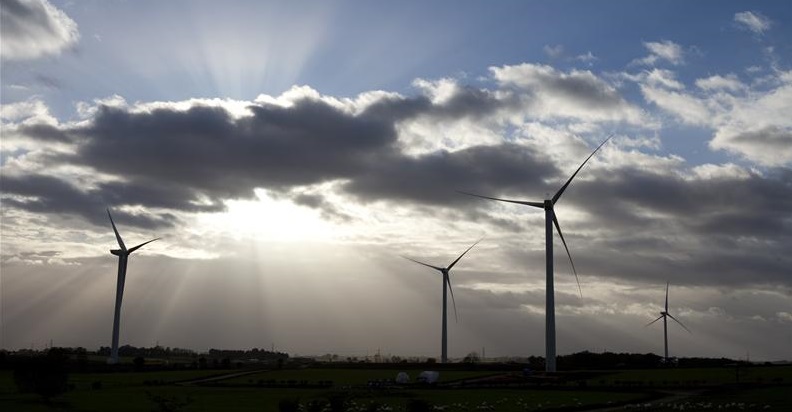
One of the largest dairy farms in the Peak District National Park has harnessed the benefits of wind power to ease the pressures of falling farm gate milk prices and rising input costs in an effort to safeguard the family business for its next generation.
The Gosling family has farmed in the Peak District National Park for over 100 years, and from Hill Top Farm near the village of Parwich since 1963. With a herd of 400 dairy cows and an additional 400 beef and dairy followers, the farm extends to 765 acres and is one of the largest dairy enterprises in Derbyshire.
Despite the scale of the farm’s operations, the family-run business remains under the constant threat of volatile income levels. Locally, farm gate milk prices have fallen by almost 40% in the last 12 months and are not expected to improve for another 12 months according to dairy industry insiders. Indeed, DEFRA reports a national drop of 26% over the same period.
“Milk prices have become increasingly unstable over recent years due to the global economic downturn, removal of EU milk quotas and the globalisation of the industry,” Robert Gosling explains. “This means we’ve had to work very hard to improve efficiencies and reduce our production costs.” Despite many operational improvements, the farm still struggles against falling commodity prices, as Robert explains; “During the same period, input prices and production costs have increased, thereby negating any savings.”
“With a peak electricity requirement during the farm’s twice-daily milking regime equivalent to that of a small village, electricity is one of our biggest variable costs,” he adds. “Over the last five years our electricity bill has doubled to an astonishing £20,000 per year. We therefore needed to find a way to not only reduce our energy costs, but also generate an income to supplement our falling milk income and return the business to profit.”
This scenario of increasing costs and falling prices is pushing many British farms to the brink or out of business. This trend not only leaves nothing to future generations, but also erodes output of British food. Robert, like many other farmers, began investigating various renewable energy options as far back as 2009 and found that wind energy was the most practical solution to meeting the farm’s energy needs.
“Our elevated location means we’ve got an abundant and reliable supply of wind,” Robert continues. “We therefore applied for planning permission to install a medium-sized, 250 kilowatt turbine near the farm buildings.”
Despite receiving the support of the local residents, the original planning application – for a 48 metre turbine – was rejected by the local planning authority due to visual impact concerns. A new application for two smaller 50kW turbines, was therefore submitted.
“After a few delays, we were granted permission to install two Endurance E3120 turbines which were erected in the first half of 2014,” Robert explains. “They were the first farm-scale wind turbines to be installed in a UK National Park, and have rapidly become an accepted part of the farming community.
“As custodians of the countryside, we help to maintain the traditional patchwork of dry stone wall enclosed pastures and participate in a number of environmental enrichment schemes to improve the natural biodiversity of the landscape in which we farm,” Robert explains.
“In my opinion, the turbines are an extension of this environmental work as they reduce the farm’s reliance on fossil fuels and have helped to secure the farm’s long-term viability. That in turn will allow us to continue in our role as environmental and countryside stewards.”
The electricity that the turbines generate is used to power the farm’s milking and milk cooling equipment, with any excess exported back into the grid.
“We’re using approximately 50% of the power we produce and selling the remaining 50%,” Robert continues. “Since the turbines were commissioned last spring they’ve produced approximately 350,000 kilowatts and contributed about £20,000 per annum to the business. That’s akin to knocking one penny per litre off our costs of production. For a business of our size, which currently receives just 23 pence per litre, it’s a significant contribution.
“Dairy farmers are always being told to cut costs and diversify in order to tackle falling farm profits. We’ve achieved that by investing in clean energy production. Without the electricity cost offset and income generated by the turbines, our business would struggle to cope with the volatile market prices, and I’m afraid to say our overdraft would be much larger than it is already.”
The future of a Derbyshire cheese factory attached to one of Britain’s largest dairy farms is at risk should it fail to get permission for a small-scale wind turbine to offset its energy costs.
Hartington Creamery, which was opened by a group of five entrepreneurial cheese lovers in October 2012, has brought the craft of making traditional British Stilton back to Derbyshire following the closure of the Long Clawson Hartington Dairy in May 2009. The creamery operates from Pikehall Farm in the heart of the Peak District National Park, which is owned by the Gosling Family.
The Goslings, who also own Hill Top Farm, in Parwich, Derbyshire, have already installed two Endurance E3120 turbines to ease the growing pressures of falling farm gate milk prices and rising input costs. They have been so impressed by the performance, reliability and financial contribution of their Endurance machines that they are supporting the tenant on their second farm with a planning application for an identical turbine.
Hartlington Creamery has found it difficult to obtain the financing needed to expand its specialty stilton cheese-making business. Like the Goslings, they’ve investigated alternative revenue sources and identified a farm-scale wind turbine as the best solution.
The cost savings on electricity alone would allow the cheese factory to expand its production output from four days per week to six, creating new jobs and supporting the local economy.
